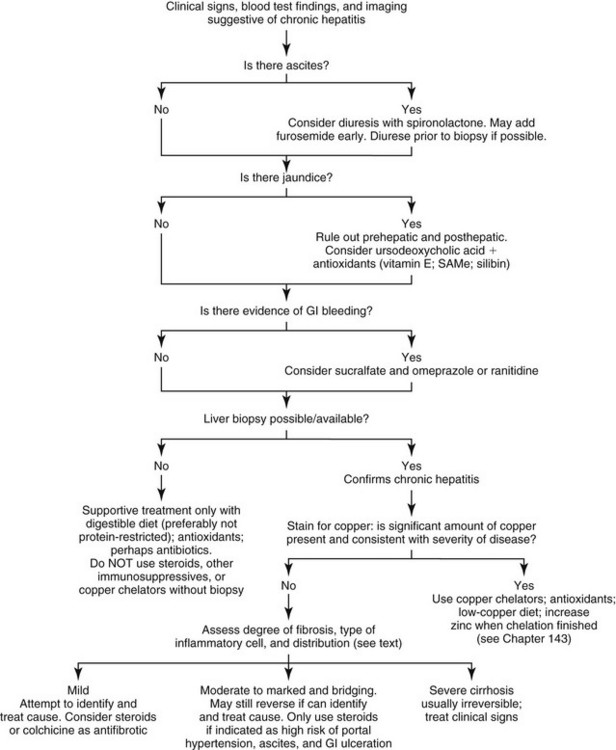Chapter 142 The most effective treatment for CH is to treat the primary etiology. However, although canine CH is common, it is a frustrating disease in dogs because the cause is often unknown. One recent pathology study suggested as many as 12% of dogs from first opinion veterinary practices had histologic lesions in the liver consistent with CH by the time of death from any disease (Watson et al, 2010). Any breeds and crossbreeds can suffer from CH, but studies of CH from various countries in various decades have noted increased breed prevalence, some of which are consistent between countries and decades and some of which have changed. Although not definitively proving an inherited basis for CH in certain dog breeds, these findings certainly are suggestive of a genetic basis to the disease. Potential and proven causes of canine CH are detailed in Table 142-1 and include copper storage disease, chronic drug toxicities, and a number of proven or suggested infectious agents. However, many cases remain idiopathic, and a number of these may have autoimmune hepatitis. This has not been proven conclusively in canine CH; however, it is suspected from recent work in Doberman pinschers in Scandinavia and also may occur in other breeds. Some of the other idiopathic cases may have a currently unknown canine chronic hepatitis virus. This has been suspected for a number of years, since the first description of a transmissible “acidophil cell hepatitis virus” in Glasgow in the 1980s (Jarrett and O’Neil, 1985). Some canine CH cases look clinically and histologically similar to chronic viral hepatitis in humans, but the putative virus has yet to be identified. Therefore currently it is difficult if not impossible for a clinician or pathologist to determine whether a particular non-copper-associated canine CH case is potentially viral or autoimmune, which obviously has profound implications for treatment, particularly with immunosuppressive drugs. TABLE 142-1 Known and Potential Causes of Chronic Hepatitis in Dogs The approach to treatment of canine CH is outlined in Figure 142-1. The aims of treatment of any dog with CH are the following: • To treat the underlying cause, if this can be identified • To try to slow progression of the disease even if the cause is not identified • To support liver function as long as possible and support the dog in positive calorie and nitrogen balance • To treat the complications of liver disease that affect quality and length of life The underlying goal in all cases is to try to prevent the progression of disease to the end stage (i.e., cirrhosis). The WSAVA Liver Standardization Group defines cirrhosis as a diffuse process characterized by fibrosis of the liver and the conversion of normal liver architecture into structurally abnormal nodules. The liver has a high reserve capacity, but when loss of hepatocytes and fibrosis reduces liver function to less than 25% of normal, hepatic failure ensues, which is incompatible with life. Cirrhosis often is accompanied by the development of portal hypertension, where increased resistance to flow through the hepatic vasculature raises portal pressure, resulting in splanchnic congestion, development of ascites, and often acquired portosystemic shunts and hepatic encephalopathy (HE) (see Chapter 144). In humans, the development of portal hypertension in end-stage liver disease is a poor prognostic indicator. This has not been demonstrated specifically in dogs, although it is known that ascites is a negative prognostic indicator in canine CH (Raffan et al, 2009).
Chronic Hepatitis Therapy
Etiology
Potential Cause
Evidence in Dogs
Copper storage disease
Proven and suspected in a number of breeds
Iron storage disease (hemochromatosis)
Recognized in humans. Anecdotally reported in dogs but no published evidence except in association with massive iron overload
Other storage disease
The liver is involved in a number of rare but recognized storage diseases, which have predominant metabolic and CNS signs
α-1 antitrypsin deficiency is a locally common cause of chronic hepatitis in humans and has been suspected but not proven in Cocker spaniels
Autoimmune disease
Suspected but not clearly proven. Recent work in Doberman pinschers in Scandinavia supportive of a role in this breed
Chronic bacterial disease
Bartonella spp. have been identified in a small number of cases of chronic granulomatous hepatitis in dogs; other chronic bacterial infections could be possible, including chronic biliary tract infection with resistant organisms. There are two old reports of CH associated with hepatic infection with atypical leptospira and a single recent case report of CH associated with Ehrlichia canis
Chronic viral disease
Suspected but not proven. There may be variation in breed susceptibility to viral hepatitis, as in humans
Chronic toxic hepatopathy
Chronic alcoholism is a clear example in humans. Phenobarbital toxicity is a documented cause in dogs. Other chronic toxicities from environmental toxins or drugs should be considered, although most reported canine toxic hepatopathies are acute
Treatment Goals
Chronic Hepatitis Therapy
Only gold members can continue reading. Log In or Register to continue

Full access? Get Clinical Tree



